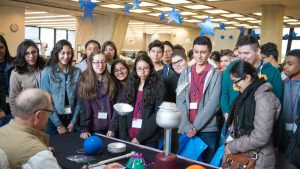
On May 2, students came to Fermilab for High Energy … High Ambitions, an event for students in demographics underrepresnted in STEM. Here they’re treated to a magnetism demo. Photo: Dan Garisto
The My Brother’s Keeper Community Challenge is a three-year-old national initiative designed to address racial inequality and combat the opportunity gap faced, in particular, by young men of color. The initiative challenges public and private organizations to participate in outreach.
On May 2, Fermilab hosted the initiative for the first time, inviting 300 high school sophomores and juniors from local communities demographically underrepresented in STEM fields to spend a day at the lab. More than a dozen people organized the event, called High Energy…High Ambitions.
“The focus of the My Brother’s Keeper event at Fermilab is to encourage grade school and high school students, especially those in underserved communities, to factor college into their plans for the future and to seriously consider STEM as a career option,” said Sandra Charles, head of the Fermilab Talent Acquisition, Diversity and Inclusion Department.
The day kicked off in Ramsey Auditorium, where Fermilab Chief Operating Officer Tim Meyer welcomed students and encouraged them to pursue careers in STEM fields, relating his own journey to Fermilab, which started when he was a teenager, flipping burgers at a fast food restaurant. Students were treated to presentations by Fermilab scientists who discussed their research on topics such as dark energy and neutrino oscillations.
“We wanted to plan the event like a conference, with vendors, breakout sessions and a keynote speaker,” said Fermilab’s Lita Scott, who helped lead and plan the event. “It was a huge team effort to get all of the moving parts to work together.”
For students like Deandre Bolden, a senior at King College Prep, the presentations were eye-opening.
“They were telling us all about gluons — I didn’t even know there were particles smaller than neutrons,” he said.
Later, the students split up to tour the lab, participate in hands-on science demonstrations, and browse a career fair with science-focused organizations such as IBM and Girls Who Code.
These activities were led by and included a broad demographic cross-section of postdocs, scientists, engineers and computer professionals. Students were able to see themselves in the Fermilab community they were interacting with throughout the day. This kind of representation is important to the mission of My Brother’s Keeper, according to Charles.
“Having the opportunity to ask questions of people who look like them is key to dispelling doubt that may cause students to question their abilities and dreams for the future,” she said.
Fermilab scientist Brian Nord gave the keynote speech about his research in astrophysics and his story of growing up as an underrepresented minority interested in a STEM career.
“The students were mesmerized,” Scott said. “Not only is he cool and smart, he is someone the students could relate to.”
Students who are underrepresented minorities or who grow up economically disenfranchised often lack the exposure to science and guidance from mentors or family that can help lead to a STEM career. According to the American Physical Society, less than 10 percent of all physics degrees are awarded to underrepresented minorities.
“Bringing students to the laboratory takes away some of the mystery as to what exactly Fermilab is,” Charles said. “Being here helps broaden their ability to dream and perhaps it grows their ambition.”
Sometimes, it’s just a matter of knowing what’s out there.
“I used to see Wilson Hall when I drove past every day,” said Taylor Davis, a junior at Waubonsie High School. “But I didn’t know how much actually went on here until today.”



